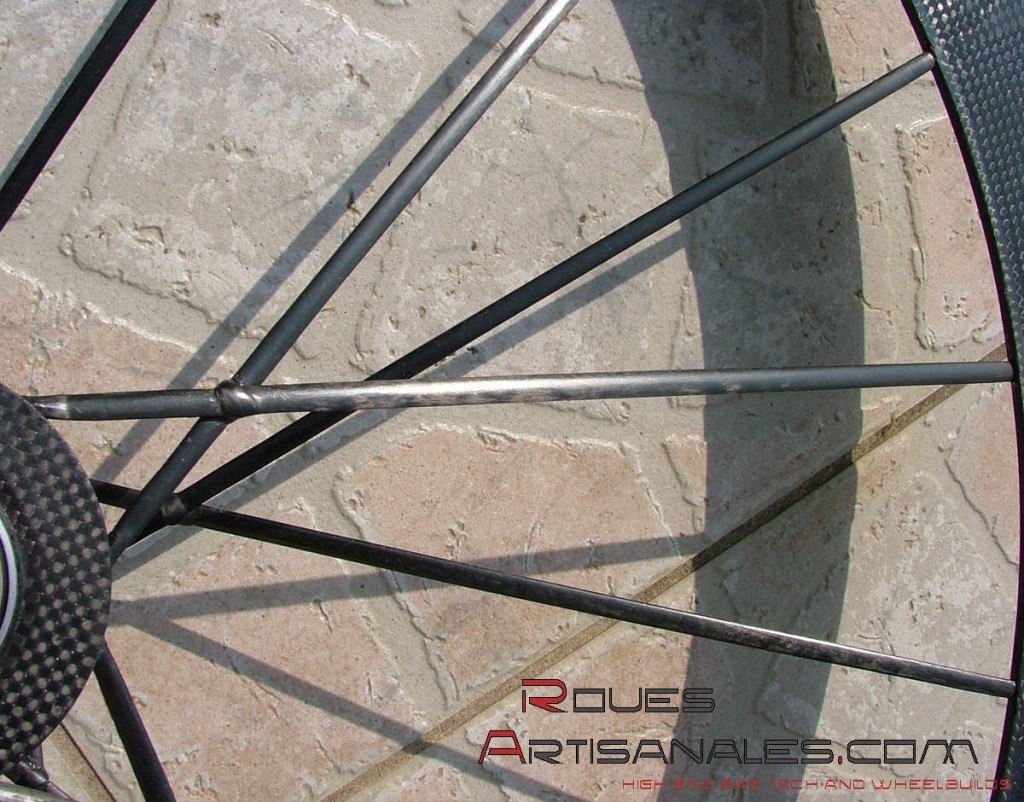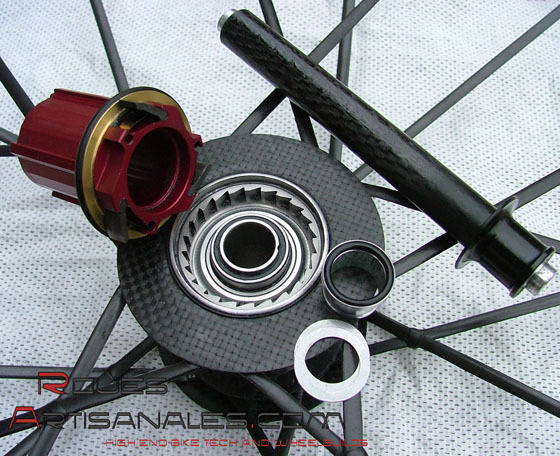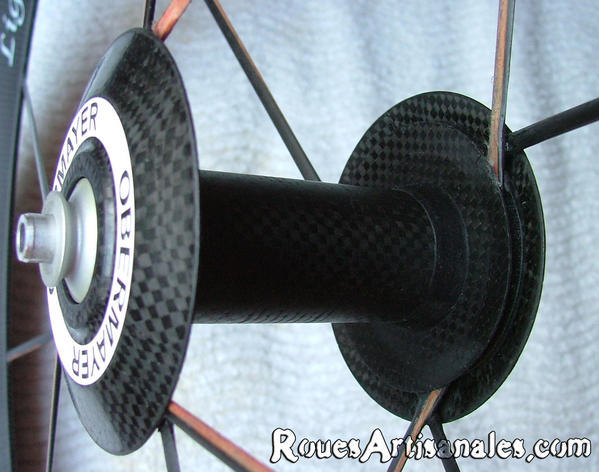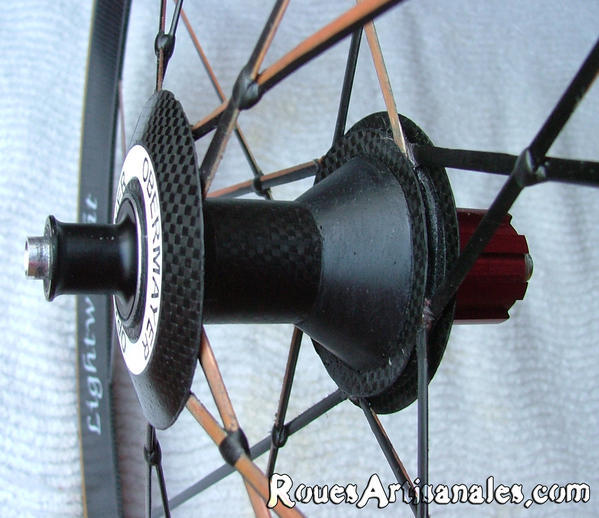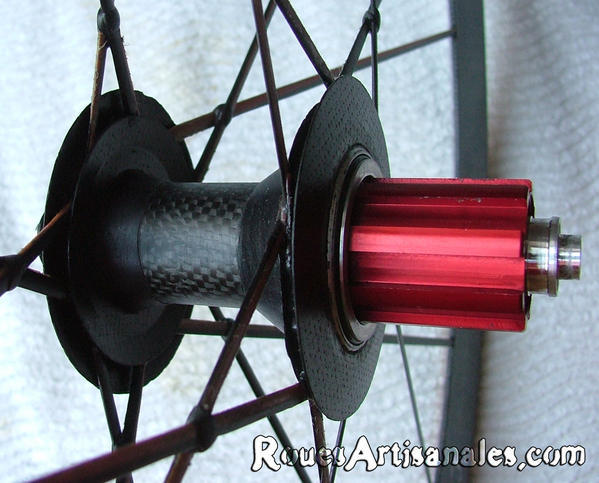Lightweight Obermayer Generation II 922g !
Comme vous avez certainement remarqué, je n’ai pas été très actif sur le site ces derniers temps. Le stage pour le magasine « L’Acheteur Cycliste » prend beaucoup de temps et le temps libre pour avancer ici sur le site est très limité.
Jeudi était ferié donc j’ai eu le temps de présenter en anglais ce qui a été, depuis presque une décennie, les roues les plus légères, les plus rigides jamais réalisées. Voici donc la traduction de cet article.
Nous avons pu visiter l’usine Lightweight pendant l’Eurobike, j’éspère que vous avez aimé cet article qui est toujours en ligne: The secret of Lightweight wheels! (en anglais uniquement, la version française devrait suivre). Nous pensons que certains d’entre vous pourraient avoir été un peu déçu de ne pas avoir pu voir beaucoup de photos des roues Lightweight. Mais, malheuresement, nous ne pouvions pas montrer toutes les photos à cause du secret de fabrication…
C’est pourquoi, nous sommes heureux, cette fois ci de vous faire partager beaucoup de photos de ces roues. Cette paire sera testée en laboratoire et sur la route pour un grand article sur le magasine très bientôt. Restez sur le qui vive!

Cette paire est la Génération II des roues Lightweight Obermayer (
voyez ici). Le look général de ces roues reste inchangé depuis les premières versions. Seuls les mécanismes internes et la structure a changé jusqu’à présent. Ainsi, à l’origine, une paire de roues Lightweight était proche de 1250g avec un mécanisme Dura-Ace ou Record et 20 rayons avant et arrière. Dorénavant, le poids maximal des Obermayer II, la version avec le mécanisme de roue arrière TUNE, et 12/20 rayons est de 960g… notre paire n’affiche qu’un pur 922g! (408g pour l’avant et 514g l’arrière)
Nous pensons que la « guerre » entre Lew Racing, réalisant la PRO VT1 à 880 / 920g (Shima/Campa) et Carbon-Sports, propriétaire des roues Lightweight, pourrait avoir blessé l’ego de la marque allemande qui se sent obligé de pousser encore plus les limites de ses roues!
Bien sûr, cette compétition entre les compagnies est très bon pour le client final puisque les produits deviennent de meilleur qualité pour moins cher.
| Stefan Behrens, à la tête de CarbonSports a été très réactif pour nous fournir une paire en test pour le magasine. Ce n’était qu’une question de jours. Nous les félicitons! |
 |
D’un autre côté, nous attendons toujours pour d’autres roues high-tech de deux autres compagnies.
Il semble que les autres ne peuvent pas produire, pour l’instant, assez de roues pour nous en envoyer une paire. Nous espérons que cette situation cessera bientôt. |
|
D’un point de vue technique, les Obermayer Generation 2 sont formidables pour n’importe quel composant.
La hauteur des jante est de 53mm pour 19,5mm de largeur. Leur squelette est en mousse, ce qui apporte rigidité et résistance à la compression. Pour la deuxième génération, une nouvelle mousse est utilisée. C’est la même que celle prenant place dans les ailes des A380, elle est plus légère et plus rigide. La fibre de carbone utilisée est « l’historique » 3K, elle est assez fine et est composée de 3000 fibres de carbone par tresse. Le côté esthétique est très bon, même si l’on peut remarquer quelques trous en inspectant de très près.
Le bord intérieur de la jante est plat. C’est une particularité que nous n’attendions pas d’une paire de roue annoncée comme aérodynamique, donc rapide. Nous pensons qu’il y a ici une grosse amélioration à apporter à la jante. Une pièce plate n’est pas réellement aérodynamique et ceci explique sans doute le mauvais résultat de ces roues au test aérodynamique du magasine TOUR. Vous pouvez le voir ici, la roue Lightweight avant absorbe 24,8W et, n’est pas parmi les plus rapides en dépit de sa jante haute.

Cliquez pour élargir.
Un trou d’une forme spéciale est moulé pour le prolongateur de valve, c’est très bien réalisé mais c’est un peu trop grand pour notre prolongateur. C’est pourquoi nous devrons le bloquer pour éviter le fameux bruit « tic-tic-tic » en roulant. Rien de bien important ceci dit. Nous pensions utiliser du scotch d’életricien autour du prolongateur pour ça. Une autre possibilité est de couper un petit bout de butyl à partir d’une chambre à air pour bloquer le prolongateur.
Mais, en tant que perfectionniste, Carbon-Sports offre deux joints très fins pour éviter que les prolongateurs entrent en contact avec le trou moulé dans la jante. C’est avec ces petits détails que l’on reconnaît les meilleurs marques!
Un aimant est intégré à la structure donc il n’y a pas besoin d’en placer un, qui pourrait être gros ou laid, sur un rayon. Bon point!
Concernant la piste de freinage, c’est du carbone normal et des patins spéciaux sont nécessaires. Carbon-Sports recommande les Swissstop Race 2000 (voyez ici) au caoutchouc modifié pour Lightweight.
A l’instar des jantes, les moyeux sont réalisés à partir de carbone 3K. Le look est aussi acrocheur et assorti. Nous pouvons constater quelques trous dans le carbone, c’est commun pour les pièces high-tech légères pour vélo et ce n’est définitivement pas un problème pour l’utilisation et la fiabilité. Mais nous pouvions nous attendre à plus pour quelque chose d’aussi cher. Pas besoin de se plaindre vraiment non plus, ça reste un détail!
Moyeu avant
Cliquez pour élargir.
Moyeu arrière
Cliquez pour élargir.
Cliquez pour élargir.
Les trous dans le carbone
Les rayons sont réalisés à partir de fibres de carbone et de kevlar. Ils peuvent résister jusqu’à 1200kg de tension sans augmentation significative de leur longueur. Leur forme est quasi elliptique mais diffère parfois avec le procédé de fabrication. En général, leur épaisseur est proche des 2mm et leur largeur proche de 5mm. Comme comparaison, les rayons inoxydables Cx-ray font 0,9mm d’épaisseur pour 2,3mm d’épaisseur.
Les rayons carbone / kevlar semblent être fait de bois!
Cliquez pour élargir.
A propos du procédé, globalement les jantes, les rayons et les moyeux sont laminés en une seule pièce, formant un composant très solide et très rigide. Les rayons partent de la surface de freinage de la jante, s’enroulent autour du moyeu et repartent à 140/160° (selon le nombre de rayon) vers la jante, jusqu’à sa surface de freinage.
Ok nous ne sommes pas spécialisés dans le procédé donc nous laissons les experts discuter de tout ça… mais fondamentalement, c’est ainsi que les roues sont construites. Nous pouvons aussi remarquer de la mousse (foam sur la photo) autour des rayons. Nous n’avons aucune idée de leur usage ceci dit.

|

|
| Cliquez pour agrandir |
Cliquez pour agrandir |
Ici encore, comme les jantes et les moyeux, la finition n’est pas parfaite. Quelques fibres de kevlar s’éfilochent et ne semblent pas « cuites ». L’aspect artisanal de ces roues est évident! Nous apprécions ce genre de petit défaut esthétique qui montre à quel point la haute technologie et l’artisanat du procédé sont liés et cohabitent!
Les rayons de la roue arrière sont ligaturés, comme ce que l’on fait sur les roues montées à la main. Cet appendice augmente la rigidité latérale de la roue et accroît fictivement le diamètre du flasque. Évidemment, les rayons de la roue avant ne sont pas ligaturés, ils se croisent dans le flasque.
|
|
Certains rayons sont principalement bruns…
|
|
…d’autres sont noirs!
|
|
Les différences entre les roues de la gamme Lightweight ont principalement rapport aux mécanismes internes et aux roulements. Les roues avant Standard et Obermayer utiisent des roulements GRW, fabriqués sur mesure pour les moyeux avant Lightweight.
La différence principale entre les deux versions que Carbon-Sports offre est donc en rapport avec le moyeu arrière. La version standard tourne sur un mécanisme de moyeu arrière DTSwiss avec son système à rochets breveté (ratchet sur la photo) . Tandis que les Obermayer utilisent le mécanisme TUNE avec le double roulement breveté aussi. Les deux mécanismes sont très fiables et durables mais le TUNE utilise un axe carbone et est bien plus léger.
| Mécanisme DTSwiss à rochers
|
 |
| Rochers (ratchets)
|


|
| Mécanisme TUNE traditionnel |
|
Les dents d’engagement sont identiques aux derniers moyeux arrière TUNE.
|

|

|
Prenez l’axe, les roulements, le corps de roue libre d’un moyeu arrière TUNE Mag150 or 160 et vous aurez le mécanisme du moye arrière Obermayer.
|

|
| Roulement double breveté pour TUNE
|

|
|
|
|
Concernant le voile, le saut et le centrage, les roues Lightweight ne sont pas parfaites. Elles voilent plus que n’importe quelle roue montée à la main sur laquelle le monteur s’est appliqué longtemps pour obtenir quelque chose de très rond. Ce problème est causé par le procédé de cuisson, la forme de la roue est quasiment achevée quant elle quitte le four et, elle doit ensuite être ajustée légèrement à la main. Attention cependant, ceci n’a aucun impact négatif sur le fonctionnement et le freinage car ça reste très faible. Oui, il ne faut pas trop s’inquiéter sur ce point. En revanche, à propos du centrage, c’est un peu plus inquiétant puisque ça pourrait affecter légèrement l’équilibre du vélo.
Au niveau de la douceur des roulements, la roue avant tourne sans plus jamais s’arrêter… vous pouvez la regarder tourner pendant des heures. C’est impressionnant, vraiment impressionnant! L’arrière n’est par contre pas du même niveau. Il est bien plus sérré et réclame quelques kilomètres pour être rodé. C’est commun sur les moyeux arrière TUNE à axe carbone et, bien sûr la Obermayer 2 suit la même règle.
Nous sommes impatients de rouler avec et d’avoir les résultats du laboratoire!
Oui c’est un fait, bien que j’ai pu rouler sur pas mal de bonnes roues que j’ai monté, je suis impatient de rouler avec les Obermayer 2 et j’espère m’éclater. En réalité, je ne vois pas pourquoi je ne m’amuserai pas. Rouler avec des roues de 922g est quelque chose de très spécial, seulement quelques personnes peuvent se le permettre et je suis ravi de pouvoir le faire pour quelques sorties. Un rapport complet du match avec les deux autres paires de roues high-tech sera publié dans le magasine où je bosse. Je pense pouvoir écrire sur RouesArtisanales un article similaire à celui ci à propos des deux autres paires dès que nous les recevrons.
Carbon-Sports a été la compagnie la plus rapide pour nous fournir un set de roues. C’est, à la date d’aujourd’hui, la seule qui a pu nous fournir une paire. C’est un point important et ça montre à quel point ils ont confiance en leurs produits.
Lightweight Obermayer Generation II éffleurant la balance avec 922g!



















